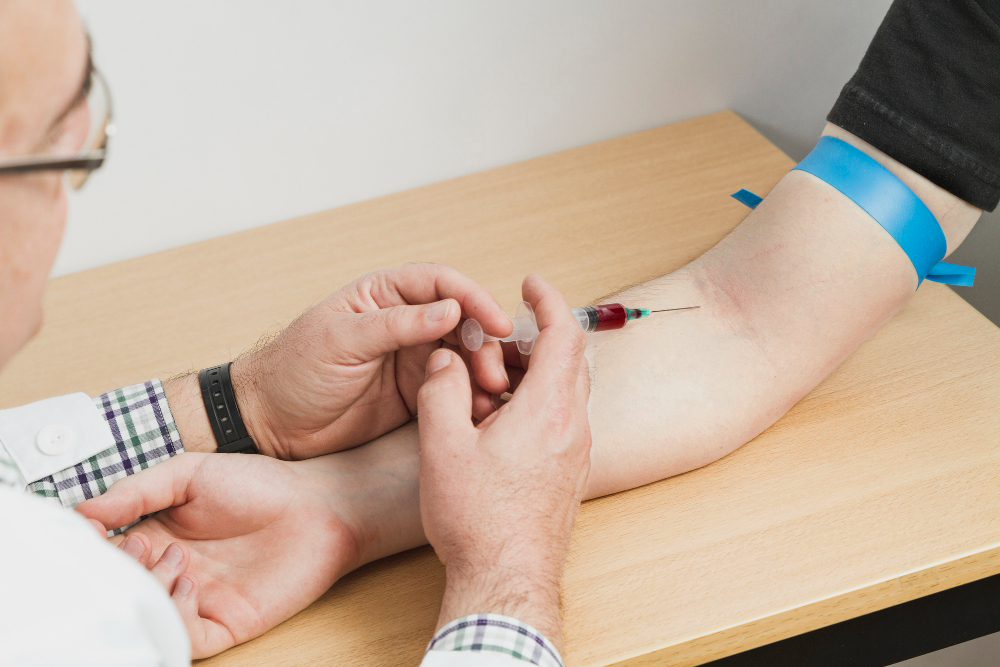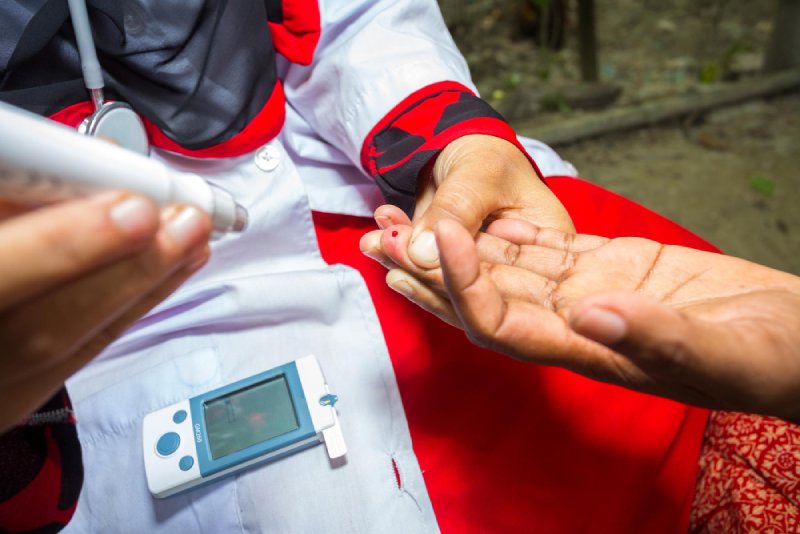Book on Whatsapp
9892101616
Why Blood Test at Home is the Future of Diagnostics
Blood Test
Tue Feb 18 2025
In recent years, healthcare has undergone a dramatic shift toward convenience and accessibility. One of the most significant advancements in this space is the ability to conduct blood tests from the comfort of one’s home. This emerging trend is reshaping diagnostics, offering numerous benefits that make it an essential part of the future of healthcare.
Convenience and Comfort
Traditional blood tests require a visit to a hospital or diagnostic center, often involving long waiting times, travel, and scheduling hassles. Home blood testing eliminates these inconveniences, allowing individuals to undergo tests at their preferred time without leaving their homes. This convenience is particularly beneficial for elderly patients, people with disabilities, and those with busy schedules.
Improved Accessibility
Many people, especially in rural and remote areas, struggle to access quality healthcare services. Home blood testing bridges this gap by enabling individuals to collect samples themselves or have a phlebotomist visit their location. This ensures that diagnostic services are available to a broader population, reducing disparities in healthcare accessibility.
Faster Results and Early Diagnosis
Time is crucial in diagnosing and treating various medical conditions. Traditional lab tests can take several days, whereas home testing services often provide quicker turnaround times. With rapid sample collection and digital result delivery, patients and doctors can identify health issues early and initiate timely treatment.
Enhanced Safety and Reduced Exposure to Infections
Visiting a hospital or clinic exposes individuals to various infections, especially during flu seasons or pandemics like COVID-19. Home blood testing minimizes this risk, making it a safer option for individuals with weakened immune systems, pregnant women, and senior citizens.
Encouraging Preventive Healthcare
Many individuals delay or avoid blood tests due to inconvenience or fear of needles. Home testing makes the process more comfortable and accessible, encouraging people to monitor their health regularly. This proactive approach can lead to early detection of diseases such as diabetes, cholesterol imbalances, and liver or kidney issues, ultimately promoting better long-
term health outcomes.
Technological Advancements Driving Growth
The rise of telemedicine and digital health platforms has significantly contributed to the adoption of home blood tests. Many services now offer user-friendly kits that require just a small finger-prick sample, eliminating the need for syringes and professional assistance. Advanced AI-driven platforms also provide detailed insights and trend analysis, helping individuals and healthcare professionals make informed decisions.
Cost-Effectiveness
Home blood tests can be more affordable than traditional lab tests, as they reduce overhead costs such as hospital infrastructure and administrative expenses. Many diagnostic companies offer subscription-based models, making routine health checkups more budget-friendly. Additionally, home testing minimizes indirect costs like travel expenses and lost work hours.
The Future of Home Blood Testing
As technology continues to evolve, we can expect even more sophisticated home testing options. Innovations such as wearable biosensors and real-time monitoring devices will further enhance diagnostics, making it possible to detect and manage health conditions instantly. With increased acceptance by healthcare providers and regulatory bodies, home blood testing is set to become a standard practice in preventive and diagnostic medicine.
Conclusion
Home blood testing represents a significant leap in the way medical diagnostics are conducted. By offering convenience, safety, accessibility, and efficiency, it is paving the way for a future where healthcare is more patient-centric. As adoption grows and technology advances, home diagnostics will play a crucial role in promoting a healthier, more proactive
society.
Related Tests
Related Packages
Related Blogs

Blood Test
HbA1c Blood Test for Long-Term Diabetes Control
Managing diabetes is not just about keeping track of daily blood sugar readings it is about maintaining long-term stability. One of the most trusted tools for this purpose is the HbA1c blood test, often referred to as the “three-month average test”. it reveals how well your blood sugar has been managed over the past 8 to 12 weeks. For anyone living with diabetes, this test plays a vital role in monitoring health and preventing future complications.
What is the HbA1c Test?
Hemoglobin A1c (HbA1c) is a simple blood test that measures the percentage of hemoglobin, the protein in red blood cells that carries oxygen, coated with sugar (glucose). When glucose circulates in your blood, it naturally attaches to hemoglobin. The higher your blood sugar levels, the more glucose sticks to the hemoglobin. Since red blood cells live for about three months, the HbA1c test gives an average picture of your blood sugar levels over that period, unlike daily finger-prick tests, which show only current levels.
Why is it Important?
The HbA1c test is essential for both diagnosing diabetes and monitoring its control.
- A normal HbA1c level is usually below 5.7%.
- Levels between 5.7% and 6.4% may indicate prediabetes,
- Levels of 6.5% or higher suggest diabetes.
For people already diagnosed, doctors often recommend keeping HbA1c below 7% to reduce the risk of complications.
Unlike random blood sugar checks that fluctuate depending on meals, stress, or activity, HbA1c provides a clearer and more reliable picture of overall control. This helps doctors adjust medications, lifestyle plans, and treatment strategies more effectively.
Benefits of the HbA1c Test
- Long-Term Insight – Instead of worrying about one or two high readings, the HbA1c test shows your overall pattern.
- Convenient – No fasting is required. You can take this test at any time of the day.
- Early Warning System – Consistently high HbA1c levels warn of poor control, which could lead to complications such as kidney damage, heart disease, eye problems, or nerve issues.
- Motivation for Lifestyle Changes – Seeing your HbA1c improve can be highly motivating, encouraging healthier food choices, regular exercise, and proper medication use.
How Often Should You Take the Test?
For people with diabetes, doctors usually recommend taking the HbA1c test at least twice a year. However, if treatment is being adjusted or blood sugar levels are unstable, the test may be advised every three months. For individuals at risk of diabetes, routine testing can help detect the condition early and prevent it from progressing.
Improving Your HbA1c Levels
Lowering HbA1c is possible with consistent effort. Here are some effective strategies:
- Balanced Diet – Include more whole grains, vegetables, lean proteins, and fiber-rich foods while limiting refined sugars and processed snacks.
- Regular Exercise – Aim for at least 30 minutes of physical activity most days of the week.
- Medication Adherence – Take diabetes medicines or insulin as prescribed by your doctor.
- Stress Management – Stress can raise blood sugar, so relaxation techniques such as yoga, meditation, or deep breathing can help.
- Regular Monitoring – Combine home blood sugar checks with HbA1c testing to stay on track.
The HbA1c test is more than just a number; it serves as a health compass that guides people living with diabetes toward long-term control and better quality of life. By offering a reliable picture of how well blood sugar has been managed over months, it empowers individuals and doctors to take timely action. Regular HbA1c testing, along with a healthy lifestyle and proper treatment, is the key to reducing complications and living well with diabetes.
At Manipal TRUtest, we offer comprehensive diabetes testing packages, including HbA1c test, to help you stay on top of your health. Early monitoring leads to better outcomes—schedule your test today.

Blood Test
Know the Reason Behind Your Fever with a Blood Test
Fever is one of the most common symptoms experienced by people of all ages. It is not a disease but a warning sign that the body is fighting an infection or responding to an underlying health issue. While occasional, mild fevers often resolve on their own, persistent or high-grade fever should never be ignored. Understanding the root cause of fever is crucial , and this is where a blood test plays a vital role.
Why Fever Occurs
Fever occurs when the body’s temperature rises above the normal range, usually in response to an infection. This rise in temperature is the immune system’s way of creating an environment less favourable for bacteria or viruses to survive. Common causes of fever include –
- viral infections (such as flu or dengue),
- bacterial infections (such as typhoid or urinary tract infections),
- parasitic diseases (such as malaria), and
- inflammatory or autoimmune conditions.
- side effects of medication or a sign of more serious illnesses.
The Role of Blood Tests in Identifying the Cause
When a fever lasts more than a couple of days, or when its origin is unclear, a blood test becomes an important diagnostic tool. It helps doctors pinpoint the underlying cause, differentiate between bacterial and viral infections, and assess the severity of the illness.
Some common blood tests for fever diagnosis include:
- Complete Blood Count (CBC) – Evaluates the levels of red and white blood cells, helping detect infections, anaemia, or blood disorders.
- Blood Culture – Identifies bacteria or fungi in the blood, guiding doctors in selecting the right antibiotics.
- Malaria Parasite Test – Detects the presence of malaria-causing parasites.
- Dengue NS1 Antigen and Antibody Tests – Confirms dengue fever and determines its stage.
- Typhoid Tests (Widal or TyphiDot) – Diagnose typhoid fever caused by Salmonella bacteria.
- ESR and CRP Tests – Measure inflammation levels in the body, useful for detecting infections or autoimmune conditions.
Benefits of Early Diagnosis
Timely blood testing not only helps confirm the cause of fever but also ensures that the right treatment is started without delay. This prevents complications, reduces the duration of illness, and avoids unnecessary use of antibiotics in cases where they are not required. For example, if a blood test confirms a viral infection, supportive care may be sufficient; but if it points to a bacterial infection, the correct antibiotics can be prescribed immediately.
When to Seek Medical Help
You should consult a doctor and consider a blood test if your fever is high-grade (above 102°F), lasts for more than 3 days, is accompanied by severe symptoms like rash, persistent vomiting, breathing difficulties, chest pain, confusion, or if it occurs in infants, elderly individuals, or people with weakened immunity.
A fever should never be dismissed as “just a common symptom.” It is your body’s way of asking for attention. Blood tests are the most reliable way to uncover the real cause, enabling your doctor to provide the most effective treatment.
At Manipal TRUtest, we provide comprehensive fever panels with accurate results, doorstep sample collection, and NABL-accredited labs — helping you recover faster with the right care.
Don’t let an unexplained fever go unchecked. Book your Fever Blood Test Package with Manipal TRUtest today and take charge of your health.

Blood Test
Cholesterol Levels and What a Lipid Test Reveals
Cholesterol is a waxy, fat-like substance found in every cell of the human body. While it is essential for producing hormones, vitamin D, and substances that aid digestion, an excess of cholesterol in the bloodstream can pose serious health risks. Understanding your cholesterol levels through a lipid test is a crucial step in preventing heart disease, stroke, and other cardiovascular issues.
What Is Cholesterol?
Cholesterol is categorized into two main types: Low-Density Lipoprotein (LDL), often referred to as "bad" cholesterol, and High-Density Lipoprotein (HDL), known as "good" cholesterol. LDL carries cholesterol to your arteries, where it can build up and form plaques, narrowing the arteries and increasing the risk of heart attack and stroke. HDL, on the other hand, helps remove cholesterol from the bloodstream, transporting it back to the liver for excretion.
Another important component is Triglycerides, which are a type of fat found in your blood. When you eat more calories than your body needs, especially from sugar and fat, the excess is converted into triglycerides. High triglyceride levels, along with elevated LDL and low HDL, are linked to an increased risk of cardiovascular disease.
What Is a Lipid Test?
A lipid test, also known as a lipid profile or lipid panel, is a simple blood test that measures the levels of different fats in your blood. Typically, the test includes:
- Total Cholesterol: The overall amount of cholesterol in your blood.
- LDL Cholesterol: Often labelled as “bad” cholesterol because high levels can lead to plaque buildup.
- HDL Cholesterol: Known as “good” cholesterol as it helps remove LDL from the arteries.
- Triglycerides: Elevated levels can raise your risk of heart disease and may indicate metabolic syndrome or diabetes.
The test is usually performed after fasting for 9 to 12 hours, as food intake can temporarily influence lipid levels. Based on the results, your healthcare provider can assess your risk of cardiovascular disease and suggest lifestyle changes or medications if necessary.
Interpreting the Results
Normal lipid levels are typically defined as:
- Total Cholesterol: Less than 200 mg/dL
- LDL Cholesterol: Less than 100 mg/dL
- HDL Cholesterol: 60 mg/dL or higher (considered protective)
- Triglycerides: Less than 150 mg/dL
Borderline or high readings may signal the need for dietary adjustments, increased physical activity, weight management, or in some cases, medication like statins.
Importance of Regular Testing
Regular lipid testing is especially important for individuals over 40, those with a family history of heart disease, people with diabetes, obesity, or a sedentary lifestyle. Early detection of abnormal cholesterol levels can help you take proactive measures to protect your heart and overall health.
Monitoring cholesterol levels through a lipid profile test is a simple yet powerful tool in maintaining cardiovascular health. It offers valuable insights into your risk profile and can guide lifestyle modifications or medical interventions. By keeping cholesterol levels in check, you can significantly reduce your risk of heart disease and lead a healthier, longer life. Regular screening, a balanced diet, regular exercise, and stress management are key to keeping your heart strong and your cholesterol within a healthy range.
Take control of your heart health - test early, stay healthy.
